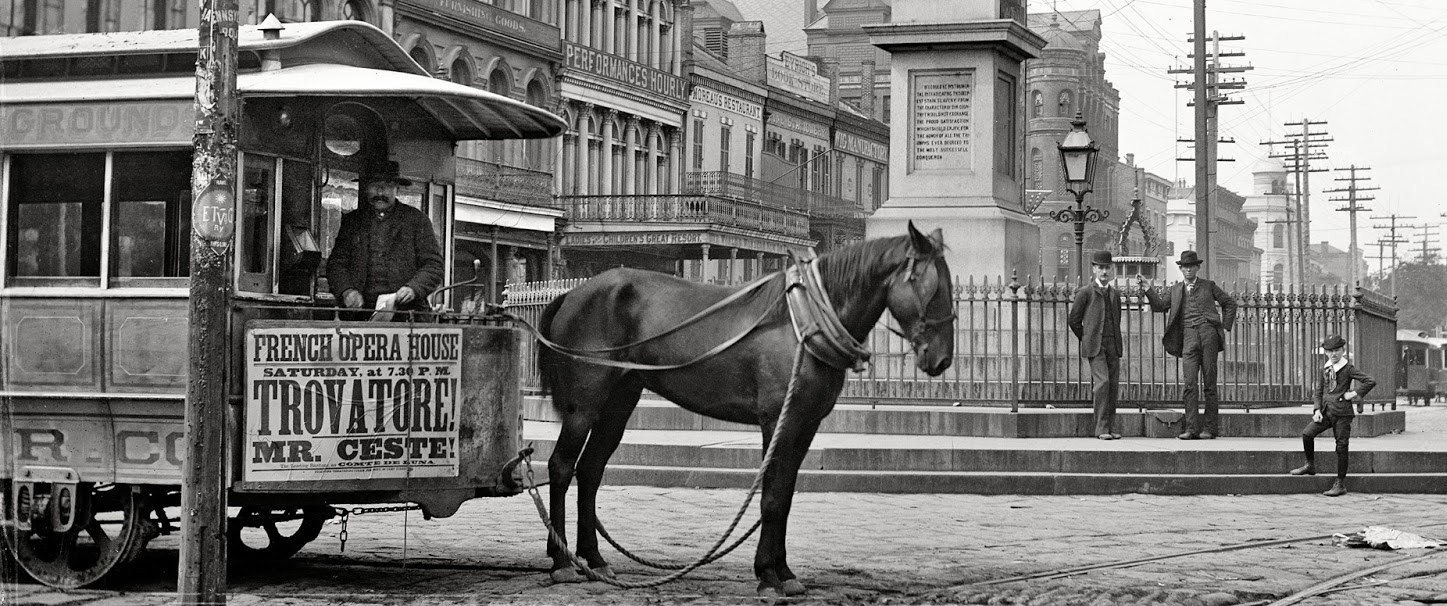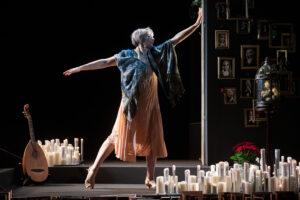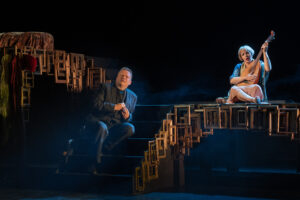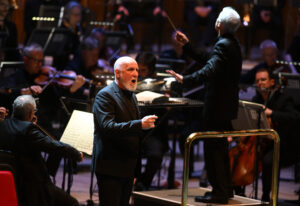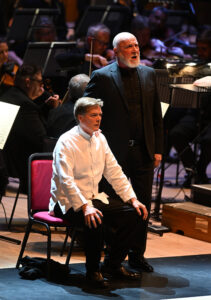In 1979, in the preface to Słownik mitów i tradycji kultury (Dictionary of Myths and Traditions of Culture), Władysław Kopaliński sounded the alarm that “the conditions of modern life (…) drive us increasingly away from our cultural heritage”. He went on to explain that “this process of the breaking of cultural ties” upsets not only identity, but also the ability to participate in the collective social consciousness. The great polymath and indefatigable lexicographer died in 2007, at the age of nearly one hundred. He was always a pessimist, but even he did not suspect that the process in question would speed up so insanely in recent decades, at the threshold of the biggest crisis of Western culture in living memory. Shying away from suffering and longing for an irretrievably lost world of habits generate an ever stronger hunger for ignorance, trigger aggression, discourage thinking.
This makes me even more impressed by the initiatives of opera companies which in the general flood of mediocrity go for works that force one to make a deeper intellectual effort, to go beyond one’s comfort zone, to reflect more insightfully on the failing mechanism of cultural inheritance. The world had to face a similar crisis – in many respects – at the turn of the twentieth century, for example. The slow agony of Romantic thinking and the painful birth of modernism produced some masterpieces that right now, at a time of growing conflicts, of the atrophy of ethics, faith and hope, we need not only to bring back from obscurity, but also to subject them to contemporary judgement, looking for their essence and, at the same time, avoiding the temptation to distort it for our own purposes.
Such works include Korngold’s Die tote Stadt, of which I have written several times that it is a metaphor for emerging from mourning, a metaphor particularly emphatic in the context of its premiere, which took place two years after the end of the Great War. That the protagonist of both Georges Rodenbach’s Bruges-la-Morte and the libretto of the opera, which Korngold and his father based on the play Le mirage, adapted for the stage by Rodenbach himself, is not a human being but Bruges – a “Venice of the North”, kingdom of medieval bankers and clothmakers, city of Memling and Van Eyck – which began to die already in the early sixteenth century, when the canals became silted up, driving the merchants and craftsmen to Antwerp, less than one hundred kilometres away. Bruges-la-Morte is regarded as one of the greatest masterpieces of symbolism. Without it there would be no Death in Venice by Mann, perhaps no Ulysses by Joyce, and according to some no Emigrants by Sebald either. The dead Bruges is also a woman, who in Rodenbach’s novella will drive a widower into madness and persuade him to kill. In Korngold’s opera she will open the gateway to another world to him, will initiate a katabasis from which – like Orpheus – the protagonist will return alone, though ready to work through his bitter loss and go into the uncertain future.
It is no coincidence that Die tote Stadt is sometimes compared with Die Frau ohne Schatten. Yet usually these comparisons are unjust, referring to the alleged “imitative” nature of young Korngold’s opera with regard to the oeuvre of Richard Strauss, over thirty years his senior. However, the most important thread these two difficult and for years neglected works share is hope – in Strauss’ case for the mourning of all the children unborn because of the war, in Korngold’s case for the mourning of all the unnecessary adult victims of the war. In both cases that hope is filtered through mourning for a lost world. Bruges in Die tote Stadt became a symbol of Vienna, degraded and deprived of its former glory. In 1915, five years before the double premiere of Korngold’s opera – in Hamburg and Cologne – Bruges-la-Morte was adapted for film by Yevgeni Bauer, who transferred it to the reality of a degraded, starving Moscow affected by a refugee crisis. Rodenbach’s masterpiece resonated throughout the war-ravaged Europe. But only in Korngold’s piece did it find a reinterpretation that gave audiences some hope for the future.
Die tote Stadt. Rachel Nicholls (Marietta). Photo: Matthew Williams-Ellis
Longborough Festival Opera initially planned to present Die tote Stadt in a semi-staged version. Fortunately, the initial concept grew and stormed onto the tiny stage of the Gloucestershire theatre in the form of a staging that was well thought out and visually stunning. The director Carmen Jakobi – in collaboration with the set designer Nat Gibson, Elaine Brown, who was responsible for stage movement, and the reliable lighting director Ben Ormerod – created an illusion of Bruges set in the turn-of-the-century Viennese imaginarium. Bridges over the canals, stairs and gates of the tenement houses were supported by a “scaffolding” made of dozens of empty frames in a reference to the geometry of Gustav Klimt’s golden squares and rectangles. The clear division of the stage into the overwhelming memorial room of the deceased wife, the cramped bedroom of the widower and the space in the middle, where the boundaries between the real world, dreams and nightmares were blurred, helped the creative team to highlight the Freudian aspects of the story. The vivid interactions between the characters brought to mind Art Nouveau allegories or the drastic expressionism of Egon Schiele’s paintings. The narrative came alive in the bright colours of Marietta and her company, only to fade a moment later in the brownish greens, gloomy blues and black of the memories of the dead Maria, just like in Klimt’s famous painting Death and Life, in which a dark, starved Grim Reaper watches an exuberant apotheosis of the human family – full of life and pushing aside into infinity the prospect of the end of the earthly wandering.
As usual, Jakobi focused on working with the singer-actors, building the characters from dozens of simple and thus even more telling gestures. Paul consolidates his obsession by repeating the same, absurdly unnecessary rituals: he organises the gallery of Maria’s portraits according to a strictly defined pattern, always lights candles in the same order in front of a relic of his beloved’s hair, and even in his own nightmares behaves like an automaton. Marietta is imperceptibly transformed from an innocent child-woman into a predatory, seductive Lilith: the spectators are no longer certain whether the supposed lookalike of the protagonist’s deceased wife is a flesh-and-blood being or merely a projection of all Paul’s fears and delusions. The church processions come as if straight from Robert le diable, where Marietta is dancing the risen abbess, but in the end turn out to be a procession of demons from the hell of Paul’s loneliness. The finale is beautifully equivocal: the widower recovers from his apathy, but we don’t know which path he will now take. Jakobi swiftly builds up tension in the silent scene of Paul’s farewell to the faithful Brigitta, only to defuse it just as quickly. There are no easy solutions here. After all, the world has collapsed. But there is hope that it can be put together anew.
Die tote Stadt. Peter Auty (Paul) and Rachel Nicholls. Photo: Matthew Williams-Ellis
The huge orchestra with its particularly elaborate percussion section had to be reduced to the size of the LFO pit. It’s good that the production team decided to use for the purpose the “Covid” version presented in late 2020 at La Monnaie. Due to the pandemic-period requirement of presenting the opera without an interval, certain cuts were made, but I must emphasise the mastery of the arrangement produced by Leonard Eröd, who limited the ensemble to less than sixty instrumentalists and yet managed to preserve the unique sound colour of the score, highlighting not only the rather obvious influences of Puccini, Strauss and Wagner, but also Korngold’s original, quite modernist ideas of expanding the harmony to the limits of the tonal system. All these elements were consistently extracted from the musicians by Justin Brown, who conducted the performance with a confident, expressive gesture to which the orchestra reacted at times with too big a sound, which certainly did not helped the singers. Still rarely presented, Die tote Stadt creates the biggest problems for the performers of the two leading roles. Contrary to what some say, the fault lies not with Korngold, but with inevitable changes in the audiences’ expectations and singing aesthetics. There are no more and probably will never again be artists who one hundred years ago were equally at home singing the protagonists of Strauss’ and Puccini’s operas, and those of Lehár’s and Suppé’s operettas. Hence the constant problems with casting the role of Maria/Marietta and Paul, which require precisely such a stylistic juggling act as well as the ability to pace oneself over the whole period. Emerging from this mostly unscathed was the excellent Rachel Nicholls, who, incidentally, joined the cast quite late and quickly mastered previously unknown material. But even in her case excessive expression led to a few shouted top notes and too wide vibrato in the middle register. Peter Auty, a singer with a strong, handsome, dark tenor was impressive in the dramatic fragments of the role of Paul, but disappointed – several times – in the quasi-operetta song “Glück, das mir verblieb”, attacking the high notes in full chest voice. Nevertheless, both artists created memorable portrayals, largely thanks to their acting skills, and I’m almost certain that with time they will be able to present true tours de force in Die tote Stadt. Among the rest of the cast particularly worthy of note were the young New Zealand baritone Benson Wilson as Frank/Fritz (especially because of the lyricism and beauty of phrasing in Pierrot’s serenade) and Stephanie Windsor-Lewis as Brigitta/Lucienne, a singer endowed with a mezzo-soprano that is assured intonation-wise and excellently placed.
This time I decided to extend my trip to the summer festival in Cotswolds by one day and end it at the Royal Festival Hall, London, with a performance of Parsifal, in Opera North’s last concert on the tour following four semi-staged performances at Leeds’ Grand Theatre. I could not let that opportunity pass: for obvious reasons nothing came out of the venture last year and it’s difficult to predict whether the excellent northern English opera company will decide to repeat it in the coming seasons. In any case, this was the first time the company tackled Wagner’s last masterpiece, which in a country of music lovers passionate about the composer’s oeuvre and usually knowledgeable about it should provide some food for thought. I myself approach Parsifal with a mixture of admiration and reverent fear. I was brought up on Knapperstbusch’s famous 1962 recording and since then I cannot stop thinking that every performance of this most complete embodiment of Wagner’s idea of Gesamtkunstwerk is an act of foolhardy bravery.
Especially given that Parsifal continues to closely guard its secret, which defies the common summary that it is a story of suffering, compassion and redemption. It ultimately convinced Nietzsche that Wagner was not a Dionysian artist after all, and forced the philosopher to finally disassociate himself from the music and aesthetics of the composer he had once worshipped. It first gave the teenage Reger a nervous breakdown and then influenced his decision to devote himself to a career in music. Last century it became the subject of numerous debates over Wagner’s racism, anti-Semitism and misogyny. One thing is certain: in musical terms Parsifal is an absolutely complete work, a recapitulation of all the most important threads in Wagner’s oeuvre, an ocean of sound from which it would be terrible to spill even a single drop. Besides, as Gurnemanz’s says, “zum Raum wird hier die Zeit”. Whatever it is, a mystery or “only” an opera, time becomes space here.
Parsifal. Brindley Sherratt (Gurnemanz). Photo: Mark Allan
I had never been to the Royal Festival Hall before and I have to admit that after the first few bars I was afraid whether a concert performance would succeed in its confrontation with the dry and very selective acoustics of the hall. Fortunately, my fears proved unfounded: Richard Farnes led Parsifal rather briskly (at least in comparison with the canonical interpretations), but with a wide breath and mostly appropriate dramatic pulse, which fell to pieces only in Act III, paradoxically slowing down the narrative. What matters is that the conductor drew up the tensions already in Act 1, effectively capturing the audience’s attention (the magnificent bells at the opening of the unveiling of the Grail, with a real Glockenklavier and a set of suspended metal plates). The vivid, clear sound of the orchestra usually did not overwhelm the singers, placed conveniently at the front of the stage.
Among them, the undisputed revelation of the evening was Brindley Sherratt, a warm and fatherly Gurnemanz, yet full of solemnity and dignity, aware of the content and emotion contained in every phrase – delivered with a velvety bass, beautiful in tone, flowing freely in all registers. Sherratt’s wise, mature approach to the role is on a par with Günther Groissböck’s lyrical Bayreuth interpretation from three years ago, and even supersedes it in technical terms. That Bayreuth cast also included Derek Welton, whose Klingsor did not seem distinctive enough for me at the time. Unfortunately, that impression persisted in London as well, which is a pity, because Welton’s is a large and handsome voice, though not very ringing in the lower register, a problem of most of today’s bass-baritones. Robert Hayward was in a class of his own as Amfortas. He is experienced enough as an artist to turn some of his shortcomings to the advantage of his interpretation. I have to admit I have a problem with judging Toby Spence’s performance in the title role. I really appreciate the singer: for his excellent technique, sensitivity and musicality. However, I still remember the times when Siegfried Jerusalem was viewed as a too “light” Parsifal. There was a reason: Spence’s delicate tenor, too, struggled at times to be heard over the dense orchestral texture. More importantly, the expressive weight of some fragments of the role was beyond him; this included “Amfortas! Die Wunde!”, where a sudden feeling of compassion borders on nearly erotic ecstasy. Spence put into the role everything he could – that in spite or everything he turned out to be a Parsifal convincing in his boyishness was thanks his above-average intelligence. A separate word of praise should go to the excellent bass Stephen Richardson: his Titurel was imperious and truly spine-chilling.
Parsifal. Toby Spence (Parsifal) and Brindley Sherratt. Photo: Mark Allan
I’ve left Kundry till the end, perhaps because Farnes made her redemption the centre of the narrative. Katarina Karnéus’ beautiful mezzo-soprano has lost a lot of its former glory, but it is still secured intonation-wise and indefatigably passionate, thanks to which it gradually became increasingly expressive. What the singer is really capable of was revealed only in Act 2. My heart almost broke after her desperate “Ich sah Ihn – Ihn – und lachte” and I have to admit that it’s been a long time since I heard a Kundry so close to seducing the pure simpleton.
I have grumbled a bit, but the finale nearly knocked us off our seats. The applause was long and well deserved. There are still places where it is possible to participate in the collective social consciousness – and this during performances of works that are difficult, force us to reflect and demand intellectual effort from both the artists and the audience. Hard times are coming. There is faith that we will not run out of hope.
Translated by: Anna Kijak
